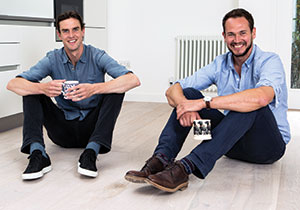From the ultimate in technology advances to more traditional bricks-and-mortar innovation, Emily Wright meets three young companies shaking up real estate in this instalment of the Estates Gazette disruptors series.
Inspired Labs
James Morris-Manuel, 28, co-founder and chief commercial officer of Inspired Labs
A former Cushman & Wakefield surveyor, Morris-Manuel is one of the driving forces behind the online virtual walkthrough tool that could change the way people buy, sell and view commercial and residential property. With clients including Hammerson, British Land and Delancey, the group has already caught the eye of some of real estate’s biggest players.
What does Inspired actually offer? We have created an online tool that is the closest thing to being at the property in person. We realised that photos are one of the limiting factors getting the property industry online. So we have replaced them with a high-definition walk-through. We put buildings online by digitally capturing the entire property inside and out. We call it Virtual Walkthrough.
How does that process work? First, a photographer visits a building with HDR cameras and systematically walks through the entire building. This usually takes one to two hours. The Walkthrough is produced entirely in the cloud and is then launched on the client’s website, complete with a portfolio of tools to help sell, lease, market, and manage the properties. These include a live chat function, links to floor plans and sustainability data and the ability for two people to use the programme at the same time with a few seconds’ delay – so that someone can lead a prospective buyer around the building, as you would do in real life.
How do you see this tool disrupting the property sector? We can help to get more of the right potential buyers in the right buildings. They can set up an instant visit and can work out in a matter of minutes whether this building is worth looking into seriously, without having to travel anywhere. This increases the sales price of buildings and makes the whole transaction significantly quicker. Buyers are able to view a higher number of properties before selecting the ones they most want to visit in person. The tool is useful for overseas sales and leasing as we are increasingly seeing scenarios where a new building requires sign-off approval of the board in another country.
What has the reaction been so far to the launch of Inspired Labs? Well, we now have 25 commercial property clients, including Hammerson, Investream, IVG, Dunedin, Wainbridge, British Land, Rowen Asset Management and Delancey, and around 50 residential clients, including Jackson-Stops & Staff, Frank Harris, Beauchamp Estates, Development Securities and Aylesford. So, that’s 70 clients now, up from 10 a year ago. As the client list grows, so do our staff numbers – up from six full-time employees to 20, plus 12 photographers, since September 2013. We have offices in London, Sweden and India and are in the process of expanding into California and Dubai.
What makes you different from everyone else operating in this sphere? We do the whole building, inside and out, every single step. You can look out of windows, into areas with less light and even corners. Traditional 360 virtual tours just spin around the middle of a room, giving users a very limited perspective of the space, and videos take away all control from the user. Buyers may not want to watch 10 whole videos of 10 buildings if the atrium is a deal-breaker. They want to be able to navigate straight to that point and, if that ticks all the boxes, then they can look at the rest.
What’s next for Inspired Labs? There are a number of technologies that are maturing, such as 3D scanning and goggle technology. These technologies will not be an addition to our product line, but a way to enhance what we already offer. And while we currently work with commercial and residential property, our technology is easily transferable to different segments. We have already expanded into hotels, shopping centres, football stadiums, museums and luxury yachts.
Latis Homes
Krishan Pattni, 32, and Robert Luck, 33, co-founders, Latis Homes
Luck and Pattni sold half of their first development of 14 affordable eco homes in Hayes, west London, in just three hours. They put a halt on the sales, relaunched a month later and sold the rest for £20,000 more before exiting at £5.6m, making an overall profit of £1.7m. They now have a £100m pipeline of 415 eco homes with a tech twist to launch over the next two years.
What makes Latis Homes different from anything else the property industry has seen in sustainable development so far?
RL: We focus on delivering mid-market, well-designed homes with a very low carbon footprint. These are not one-off, high-end eco homes for rich clients, but tech-enabled designer homes suitable for first-time buyers. We build our own properties using an in-house construction team that we built up during the recession.
KP: It helps that we choose our locations carefully. We want all our developments to be easily commutable to London, within that 40-minute bracket. Our homes are aimed at mid-market, first-time buyers. These are people who will have to work very hard for the next 20-30 years, so the commute is crucial. The rate at which those homes sold – and the return we got – proved to our backers and potential investors that we are on to something. We are looking to jump the M25 belt now into the Home Counties – Hertfordshire and Kent – to create places that make people feel like they are living in the city, just a bit further out.
RL: This also means that our homes have generous floorplans. A typical three-bed property is 1,500 sq ft. We have done that by making a narrow but deep floorplan using three floors and roof space.
KP: The idea that to have density you need a huge tower surrounded by acres of formless green space is just not true. We are proving that.
Part of Latis Homes’ sustainability element is based around technology and apps. How new is this really?
KP: Very – when it comes to mid-market homes. Technology to turn off lights, for example, has been around for some time – introduced in very expensive, high-end property in Knightsbridge and Chelsea around a decade ago. But we are using the most up-to-date versions to introduce this all the way down to first-time buyers. And we have set the systems up to help encourage users in these affordable properties to think about the way they live, without beating them round the head with it. All of our taps and showers offer a choice for full power or half water. That choice is the crucial element. Then every resident can download their annual energy monitoring and see a flow-chart of how much they have used – across water, gas and electricity – and the impact that has had on their bills. As for the app, it is deliberately very simple – or people just wouldn’t use it. It allows people to turn lights, heating and hot water off and on from their phone or tablet: if you are on holiday, you can simulate occupancy by switching the lights off and on from the beach. If you land at the airport freezing cold, you can turn on the hot water en route home.
RL: We think that what we offer is disruptive in a particular market. A market where we allow people who wouldn’t necessarily be able to afford a high-spec designed home to do so.
KP: We wanted to address the issue that there didn’t seem to be a product available where normal people would buy a contemporary new-build: architecturally designed homes at affordable prices.
 FRT Developments
FRT Developments
Ed Marsh and Tom Mees, both 33, co-founders and directors of FRT Developments
Retail surveyors Marsh and Mees set up on their own in 2012 to specialise in retail- and office-to-resi conversions of unusual spaces. The duo has most recently made a 50% return following the renovation of a historic bakery in Wandsworth, SW18, and has just started construction on a five-house development in Carshalton, SM5.
What is it that makes you different in the retail-to-resi sector?
TM: Everything we do is very different. Not least the actual projects we take on. An old bank, a little bakery. Our aim is to adapt to the history and individual feel of each property.
EM: We aren’t trying to take over the world. We know we are still very small fish. But what we have done has been entirely on our own. We have rolled every penny we have into each new scheme.
TM: And we have been running this business in the evenings and at weekends while holding down busy jobs.
EM: The way we have built the business has been dedicated and quite old-fashioned. We’ve been round London on our bikes, flyering commercial property, trying to find new stock.
Why did you decide to focus specifically on these types of projects?
EM: As retail surveyors, we are really passionate about getting disused space back into use.
TM: We started off very small – renovating a vacant building society property in Littlehampton. We did the same with an abandoned jewellery shop in Denmark Hill, south-east London, before buying the bakery building in 2012 for £405,000 and we are expecting to make over 50% profit on this.
EM: We specialise in unlocking the potential in disused commercial property and the bakery was a perfect example. The Italian family which had been baking there for more than 30 years needed to move to a production unit. We found the building in February 2012 and bought it in June that year, subject to planning. There was a huge oven, large fridge units, and hardly any light at the back. We got three units out of one and used lots of glass and very minimal, Scandinavian interiors – greys and whites – to bring in more light.
TM: We try to retain original features where we can. Like the old baker’s chimney, for example. We are now on site building five houses in south-east London which make up a development with a GDV of £2.6m. We have knocked down an obsoltete office building and have planning to develop the 6,500 sq ft site.
This is a big step for us, but it’s very much the direction we want to go in. Taking on bigger projects and being as bullish as we can.













